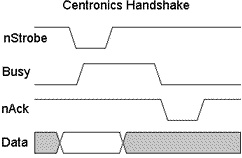

Related Links On Parallel Port
Handshake
CVGS
Parallel Port
Centronics :
Centronics is an early standard for transferring data from a host to the printer. The majority of printers use this handshake. This handshake is normally implemented using a Standard Parallel Port under software control. Below is a simplified diagram of the `Centronics' Protocol.

Handshake signals
Data is first applied on the Parallel Port pins 2 to 7. The host then checks
to see if the printer is busy. i.e. the busy line should be low. The program
then asserts the strobe, waits a minimum of 1uS, and then de-asserts the strobe.
Data is normally read by the printer/peripheral on the rising edge of the
strobe. The printer will indicate that it is busy processing data via the
Busy line. Once the printer has accepted data, it will acknowledge the byte
by a negative pulse about 5uS on the nAck line.
Quite often the host will ignore the nAck line to save time. Latter in the
Extended Capabilities Port, you will see a Fast Centronics Mode, which lets
the hardware do all the handshaking for you. All the programmer must do is
write the byte of data to the I/O port. The hardware will check to see if
the printer is busy, generate the strobe. Note that this mode commonly doesn't
check the nAck either.
Copyright © 2003 Gammaworkz. All rights reserved.